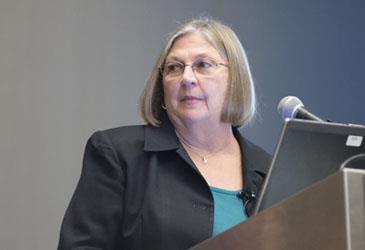When it comes to new models of care, there are many variables at play that can contribute to the success or failure of your organization. The primary factor for whether your practice will thrive in this new environment, experts say, lies with the individuals who work there.
Leaders from across medical professions came together for a special panel discussion Saturday at the 2016 AMA Annual Meeting. They agreed that one of the most important components clinicians and hospitals should be focusing on now is integrated leadership, which can ensure new models of care have an environment in which they can succeed.
“Designing the care that will be delivered to patients must be defined by clinicians—not the government,” said Liz Summy, executive vice president of the American College of Healthcare Executives. “And the only way we can do that is by working together.”
Rethinking the current leadership model
Building on the Principles of Integrated Leadership for Hospitals and Health Systems, which the AMA and the American Hospital Association (AHA) jointly released one year ago, the panel examined both what current leadership looks like in health care organizations and what is needed for the future.
“There has to be a place where … administrators, physicians and other clinicians can sit down and make decisions about the management of the organization and how it can move forward,” said John Combes, MD, chief medical officer at the AHA. “Physicians must be in the leadership of all levels of the organization. There has to be a team approach of clinicians and managers and others working together.”
But how do organizations get to that point?
“First it starts with this shared vision, shared mission, with physicians and hospitals,” Dr. Combes said. “And I think at the core, we really do have this shared mission and vision.”
Dr. Combes shared a story of one place he worked, where he would attend meetings of the administration in which the executives would complain that there was something wrong with the physicians because they didn’t share the same priorities they did. Then Dr. Combes would attend a meeting of the physicians, and they would voice the same complaint about the administration’s priorities. In reality, both groups had made taking care of patients their top priority.
It turned out that “we both had the same core mission,” Dr. Combes said, “But we didn’t have a whole lot of trust.”
He said one of the six core principles for integrated leadership that will propel new care models to success and achieve the aims of better care, better health, lower costs and improved satisfaction is changing this paradigm. “It has to be a collaborative, participatory partnership built on—and this is the key word—trust,” Dr. Combes said.
Part of that trust means that physicians and other leaders will need to share all information across the organization—that includes clinical and business details. It also means that the appropriate leaders will be included in all important decisions.
J. James Rohack, MD, a Texas cardiologist and former AMA president who is an advisor for the AMA’s Professional Satisfaction and Practice Sustainability initiative, gave the example of how physician leaders frequently are left out of decision-making about the adoption of health IT.
“Unfortunately, in many systems, the person selecting IT isn’t a clinician and is selecting technology that makes good business sense but actually impedes care at the bedside,” Dr. Rohack said.
Leadership changes will need to start with training
The current training for physicians and executives leaves gaps, Dr. Rohack said. “[As physicians,] we’re trained in a clinician-oriented, take-care-of-the-patient model.” Leadership training hasn’t been a part of medical school or residency for most physicians.
Ensuring that both administrators and physicians understand the importance of the different kinds of leaders in the organization and that there is mutual trust will require continued training, he said.
Pam Thompson, CEO of the American Organization of Nurse Executives, said training will need to start with interprofessional education in schools so integration across the professions isn’t new when physicians and other team members start working together in practice. This kind of leadership development is in fact a key component of the work underway through the AMA Accelerating Change in Medical Education Consortium.
For physicians and others already in practice, leadership training can go a long way to help fill the gaps for which they did not receive formal instruction as students and residents.
“I strongly believe that all physicians are leaders—you don’t have to be in a title role,” said Peter Angood, MD, CEO and president of the American Association for Physician Leadership. “Society certainly expects it of us. And we can impact our industry in important ways.”
Clinicians need to become “disciplined in our own leadership development,” Thompson said. “Leadership doesn’t just happen from happenstance.”
That’s especially important because “change is constant now” in health care, she said. Clinicians need to become experts at decision-making amidst ambiguity. “This whole conversation around integrated leadership is so that we can be more strategic.”
Dr. Combes summed it up: New models of care need a new model of leadership. “If you have a new model of care with the old leadership, it’s not going to work.”





